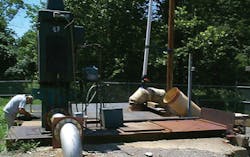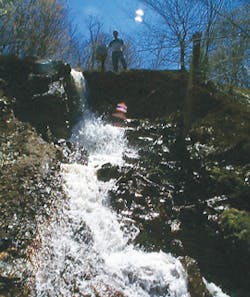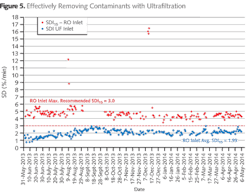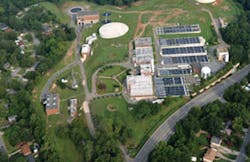By Jim Summerfield
Pure demineralized water is an essential part of nearly all industrial processes, ranging from electric power generation to refinery process steam production. The need for effective and efficient pure water production is often eclipsed by the immediate needs of just producing enough water to satisfy the daily demand. Today's water treatment technology provides plant operators and management an opportunity to improve efficiency without sacrificing efficacy.
Not all water treatment systems are identical; therefore, there is no single right solution. Whether operating a reverse osmosis (RO) system or an ion exchange demineralizer, there are several technology upgrades that exist when evaluating potential improvements to a water treatment system. These include:
- Energy savings by utilizing low-pressure or low-energy membranes
- Energy and chemical cost savings by utilizing fouling-resistant membranes
- Fewer mixed bed polisher regenerations by utilizing high-rejection membranes
- Extended throughput and lower chemical, energy and wastewater costs by utilizing uniform particle-size ion exchange resins
- Packed-bed technology
- Pretreatment technology to level off feedwater variability and provide consistent water quality to down-stream processes.
All of these technology choices can help improve system performance, provide cost savings and improved reliability.
Reverse Osmosis
Water plant professionals are all faced with the challenge to sustainably produce more water without sacrificing quality. There are options that can immediately help achieve these goals.
RO technology has evolved greatly over the past three decades. Desirable for its continuous operation and absence of chemicals for regeneration, this technology is a solid contributor in the quest for "more, better water." Energy consumption and chemical cleaning are key operating costs associated with this process.
One of the greatest achievements in minimizing the overall cost of RO operation has been the development of low-energy and high-rejection elements. This technology allows system owners to consume up to 34 percent less power. Moreover, high-rejection elements provide improved water quality and lower downstream water treatment costs by reducing or eliminating the need for mixed-bed polishing. Figure 1 shows energy cost savings using elements containing low-energy membranes.
Lower-fouling RO technology has evolved greatly as well. The benefits associated with low-fouling membranes generally justify the premium price for this technology. Combining maximum element surface area, optimized feed spacers and unique membrane chemistry, the reduction in cleaning frequency means more up-time for water production and a reduction in chemical cost and wastewater associated with cleaning. Figure 2 shows pressure drop across a membrane system purifying high-fouling water. The optimized 34-mil feed spacer has clear advantages over the other feed spacer designs. Operations with this feed spacer showed lower pressure drop initially and during operations as compared to the standard 28-mil feed spacer.
Ion Exchange Systems
Ion exchange, used to remove ionic impurities from water, is a seasoned and effective high-purity water treatment technology. Several aspects of an ion exchange system can be optimized for more efficient operation. Using true uniform, particle-size ion exchange resin will immediately help lower pressure drop across a bed of resin, consume less rinse water during regeneration and reduce backwash flow rates. In addition, better water quality can be achieved through higher regeneration efficiency, reduced leakage, improved resin separation in mixed beds, faster kinetics, and ultimately higher operating capacity.
Using ionic monitoring to determine precise end-points will greatly enhance performance, as will balancing the volume ratio of cationic and anionic resins to align with the raw water composition. In all, a 20-percent decrease in operating costs may be realized. Modeling tools are available to help evaluate and quantify the potential savings. Some older systems may not allow throughput optimization due to changes in raw water quality, but saving on rinse water and backwash water alone returns valuable cost savings. Figure 3 shows the improvement in operating capacity using uniform, particle-size resin versus traditional, conventional-sized resins.
Due to the maturity of this technology, many older systems are operating outside of their original design parameters. Since feedwater quality can change over time, the original design parameters are not applicable today. As the feedwater changes, most commonly manifested as an increase in total dissolved solids (TDS), the systems can be optimized to best accommodate the changing feedwater quality. Modeling tools are available to help pinpoint the optimum resin combination and operating conditions to best achieve the quantity and quality of water required.
Retrofitting an existing ion exchange system into a counter-current or packed-bed system is the ultimate optimization method. The economic advantages of this unique ion exchange technology are very clear, but there is a capital premium associated with high-performance, packed-bed ion exchange technology. Counter-current and packed-bed systems offer optimum operating capacity and exceptional water quality (see Fig. 4).
Pre-Treatment Technologies Ultrafiltration
Ultrafiltration technology is quickly becoming the feedwater pre-treatment technology of choice. Inconsistent suspended solids concentrations in feedwater sources from drought or flood can wreak havoc on an RO or ion exchange system. Suspended solids can quickly plug downstream processes, resulting in poorer throughput, poorer water quality and increased costs associated with cleaning and lost production.
Installing an ultrafiltration system is an excellent solution in this scenario. Ultrafiltration is also effective at removing biological contaminants. Figure 5 shows how ultrafiltration technology effectively and efficiently produced low suspended solids water from a water source with variable suspended solids. Notable are feedwater excursions with very high suspended solids concentrations where the treated water quality remained consistent.
Particle Filtration
Particle filtration covers a very large and diverse set of operations. Everything from bag filters, cartridge filters and media filters are considered particle filters. However, one technology stands alone as truly unique. TEQUATIC™ PLUS fine particle filtration technology consistently and cost-effectively combines the power of continuous cleaning, cross-flow filtration, centrifugal separation, and settling into one device. Designed to process a wide range of difficult-to-treat, high-solids water including oily water, this is a cost-effective solution to traditional filtration technologies that facilitates high uptime, reduced consumables, consistent performance, and a small footprint. Figure 6 shows the benefits of cross-flow particle filtration as it relates to the reduction of bag filter replacements costs.
Summary
Although there can never be a streamlined solution for across-the-board water treatment processes, improved water quality and cost savings can be realized through custom systems with common water treatment technologies. Most water treatment solution manufacturers have experts on hand to help optimize or completely redesign one's existing system to help improve his or her sustainability footprint while benefitting from purer water with lower cost.
About the Author: Jim Summerfield is a senior key account manager with Dow Water and Process Solutions. He has more than 20 years of experience in water treatment across multiple businesses, functions, technologies, and applications. He holds a BS in Business-Chemistry and an MBA from Saginaw Valley State University.








